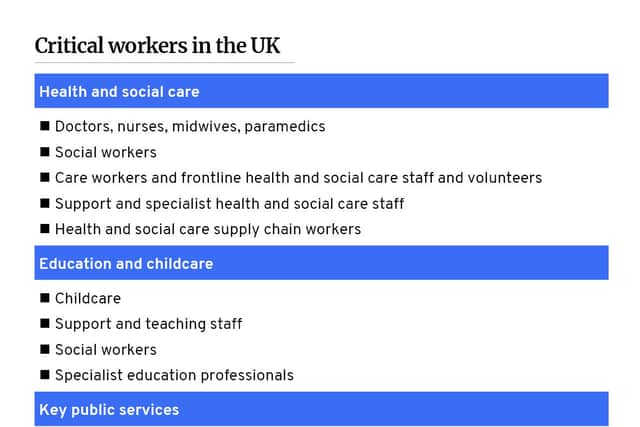Who are critical workers? Key worker status explained, list of industries and when daily Covid testing starts
and live on Freeview channel 276
Prime Minister Boris Johnson announced that key workers across several industries that keep the country running will be required to take lateral flow Covid tests daily.
But who classes as a key worker and how will the testing work?
Here’s what you need to know.
How will the testing for key workers work?
Advertisement
Hide AdAdvertisement
Hide AdPrime Minister Boris Johnson said 100,000 workers in England, "from food processing to transport to Border Force", will have to test every day they are working from 10 January.
The government will send lateral flow tests to those industries directly and will help organise the logistics.
The aim of this testing is to ensure infections are caught as early as possible in order to minimise spreading Covid to colleagues, which has been causing major staff shortages.
Critical workers will be able to take a test on every working day and the provision of precautionary testing will initially be for a period of five weeks.
When will it begin?
The testing rollout will start from Monday 10 January.
Advertisement
Hide AdAdvertisement
Hide AdTests will be separate from public sectors who already have a testing allocation with UKHSA, such as adult social care or education, and separate to those delivered to pharmacies and homes, so those channels are not set to be impacted by the new scheme.
Which key workers will be required to test daily?
The critical workers who will be required to test daily are those who work in essential services, cannot work from home and are at risk of infecting each other - for example, due to working together in an enclosed space.
Those covered by the scheme will include people who work in:
- Critical national infrastructure
- National security
- Transport
- Food distribution and processing
This includes vital roles in:
- Border Force
- Police and Fire and Rescue Services control rooms
- Electricity generation
- Test kit warehouses and test surge labs
The full range of critical workers have been identified by the relevant departments and the Government will contact these organisations directly on the logistics of the scheme this week, according to Downing Street.


What are lateral flow tests?
Advertisement
Hide AdAdvertisement
Hide AdRapid lateral flow tests help to check if someone has Covid. If people test positive and self-isolate, it helps stop the virus spreading.
Research shows rapid tests are a reliable test for Covid, as they give a quick result and do not need to be sent to a lab.
Even if you’re vaccinated, you could still catch the virus or pass it on, but doing rapid tests helps to protect yourself and others.
Currently, the general public are being advised to do rapid tests on days when they’re more likely to catch or spread Covid.
For example, do a test before you:
- mix with people in crowded indoor places
- visit someone who is at higher risk of getting seriously ill from Covid-19
Advertisement
Hide AdAdvertisement
Hide AdYou should also do daily rapid tests (one a day for seven days) if you’ve been in contact with someone with Covid and are either:
- fully vaccinated
- under 18 years and 6 months old
A message from the editor:
Thank you for reading. NationalWorld is a new national news brand, produced by a team of journalists, editors, video producers and designers who live and work across the UK. Find out more about who’s who in the team, and our editorial values. We want to start a community among our readers, so please follow us on Facebook, Twitter and Instagram, and keep the conversation going. You can also sign up to our email newsletters and get a curated selection of our best reads to your inbox every day.
Comment Guidelines
National World encourages reader discussion on our stories. User feedback, insights and back-and-forth exchanges add a rich layer of context to reporting. Please review our Community Guidelines before commenting.
